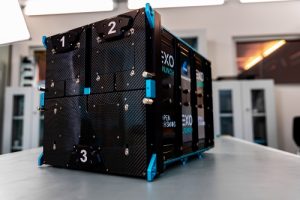The satellite carries a multispectral camera for imaging but also a computer to allow AI apps to run onboard, for adding intelligence to the processing of the data. This is done via the open source NanoSat MO Framework (NMF), which allows apps to be installed, updated and operated remotely from Earth. For example, Phisat-2 is running four AI-based apps.
First, Sat2Map, sends map data to response teams during emergencies and disasters such as floods and earthquakes.
Second, Cloud Detection, which detects, identifies and classifies clouds to give real-time insights into cloud distribution.
Third, Vessel Detection, is an app using machine learning to detect and classify vessels based on Phisat-2’s multispectral images, for real-time maritime monitoring.
Finally, the Deep Image Compression app compresses the images captured on board for more efficient transmission back to Earth.
Phisat-2
“The launch of Phisat-2 is a game changer for Earth observation,” said Jacob Bullard, Mission Manager in Operations at Open Cosmos.
“With its advanced AI applications and real-time data processing capabilities, Phisat-2 will provide invaluable insights for disaster response, maritime monitoring and environmental protection. This mission exemplifies our commitment to pushing the boundaries of space technology and delivering impactful solutions.”
Two further apps will be added: Anomalies in Marine Ecosystems, which uses machine learning to scan satellite imagery and spot anomalies in marine ecosystems (oil spills, algal blooms and sediment flooding).
And PhiFire AI, a wildfire detection app, that sends early-warning signs to response teams with a classification report that identifies the fire itself and also nearby safe, burnt and water areas.
“The successful launch of Phisat-2 once again showcases the power of collaboration between ESA and innovative companies like Open Cosmos,” said Nicola Melega, ESA’s Φsat-2 Technical Officer.
“This mission highlights how advanced AI technology can transform our ability to monitor and respond to changes on Earth, making space data more actionable and impactful than ever before.”
As mentioned, the has been funded and developed by the ESA with Open Cosmos as the prime contractor. The industrial consortium also includes Ubotica, CGI, CEiiA, GEO-K and KP-Labs and SIMERA.
See also: CogniSAT-6 satellite mission achieves AI detection of Earth objects

